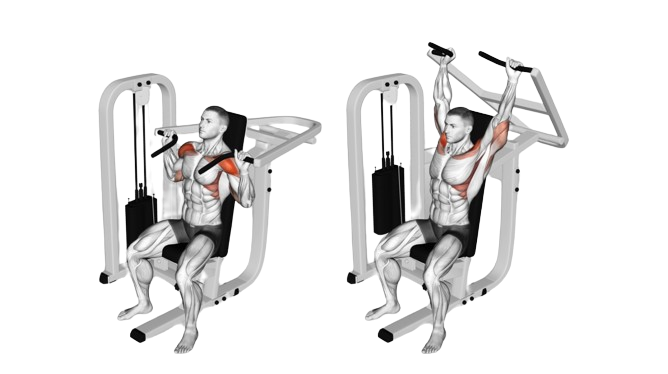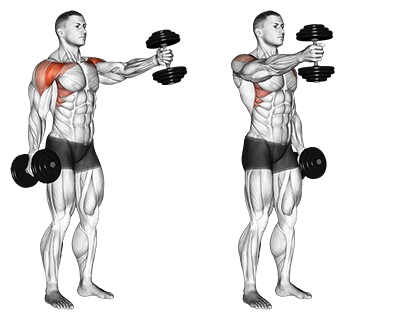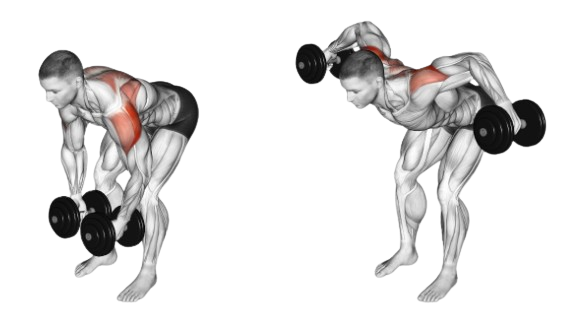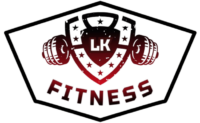Shoulder Training 101: Complete Guide to Exercises and Routines
INTRODUCTION
If you could only train one muscle group to obtain an athletic appearance and silhouette, even with clothes on, it would be the shoulders. Well-developed, round shoulders automatically make your waist seem smaller, granting you the coveted V-shape that everyone aims for. Big shoulders have always been a primary sign of exceptional upper body strength.
Beyond visual appeal, well-developed shoulders are essential for injury prevention. To train them properly, we first need to understand shoulder anatomy. The shoulder joint consists of deltoid muscles, rotator cuff muscles, and surrounding stabilizers, they work together to perform a variety of movements. The deltoid muscle has three primary heads: the Anterior head (Front delt), the Medial/Lateral head (Side delt), and the Posterior head (rear delt).
In this guide, we’ll cover each of these deltoid heads individually, ensuring you achieve balanced and effective shoulder development.
Let’s Build Those Boulder Shoulders!
The Most Effective Front Delt Training Guide
Introduction
The anterior deltoid, primarily responsible for lifting the arm forward and upward in front of your body, plays an essential role in vertical pressing movements (Lifting stuff over your head). It also assists the chest muscles during incline, horizontal, and decline pressing movements.

Essential Exercises For Developing Strong Shoulders
1. Seated Barbell Overhead Press (OHP) – Build Strong Shoulders
Seated overhead press (OHP), also known as Military press is a staple exercise for building strength and size.

How To Do It:
- Grip the barbell with your hands slightly wider than shoulder-width apart with your palms facing forward.
- Engage your core, take a deep breath, and lift the barbell off the rack.
- Move the bar to just above your upper chest.
- Exhale and press the barbell straight up (Make sure not to hit your chin), extending your arms fully but not locking out your elbows. Do not arch your back excessively while pressing the weight up, maintain the upright position of your upper body.
- Inhale and slowly lower the barbell back to the starting position, just above your chest.
- Perform 3-4 sets of 10-12 repetitions
Variations & Tips:
- Some racks have chairs attached to them, and some of them don’t.
- Some chairs have backrests for support, and some of them don’t. It’s highly recommended for beginners to use chairs with a backrest for safety. This allows you to focus on executing the movement properly without worrying about stabilizing your torso.
- Similar to various free weight exercises for the chest, it’s important to have a spotter for this exercise.
Smith-Machine Press – Excellent Alternative With Added Safety

Smith-Machine Behind The Neck Press
This is NOT a beginner-friendly exercise. You can put your shoulders in a compromised position while performing it, thus increasing the risk of injury.

Seated Dumbbell Press – Build Strong And Stable Front Delts

How To Do It:
- Adjust the incline bench to a 60-90 degree angle, or use the chair with a fixed backrest. Ensure the chair is stable and securely locked in place.
- Grab a pair of dumbbells, sit on a pad, and place the dumbbells on your upper thighs.
- Kick your legs up to help lift the dumbbells to the starting position directly above your shoulders and slightly lean into the backrest for support.
- Engage your core, take a deep breath, and press the weight straight up with your palms facing away from you and fully extend your arms.
- Slowly lower the dumbbells down in a controlled manner as you exhale.
- Perform 3-4 sets of 12-15 repetitions.
Machine Presses – Excellent For Focusing On Front Delts
The machine shoulder press is a fantastic tool for isolating the anterior deltoid due to its fixed movement pattern. Unlike free weight exercises such as the barbell and dumbbell overhead presses, which also engage the rotator cuff and small stabilizer muscles around the shoulder joint, the machine allows you to focus more on the main shoulder muscles throughout the entire exercise.


How To Do It:
- Adjust the seat height so that the handles are at shoulder level when you are seated.
- Choose an appropriate weight setting on the machine based on your strength and fitness level.
- Exhale and push the handles upward until your arms are fully extended but not locked out.
- Keep your back against the backrest and maintain a stable posture throughout the movement.
- Inhale and slowly lower the handles back to the starting position at shoulder level, and control the movement to prevent the weights from slamming down.
- Perform 3-4 sets of 12-15 repetitions
Variations & Tips:
- Seated shoulder press machines are great for a warm-up, start slow and gradually increase the weight as you get comfortable with the movement.
- There are numerous variations of shoulder press machines, all serving the same purpose but differing in design. Some of them are plate-loaded, while others feature a weight stack. Some shoulder press machines may have different grip options or adjustments for hand positioning. Experiment to find the grip that feels most comfortable and targets your shoulder muscles effectively.
3. Front Raises – Isolates Anterior Deltoids

How To Do It:
- Stand with your feet shoulder-width apart, core engaged, and knees slightly bent for stability.
- Hold a dumbbell in each hand with your palms facing your thighs. This is your starting position.
- Keeping your arms straight (but not locked), exhale and lift the dumbbells directly in front of you.
- Aim to raise the dumbbells until they are at shoulder level. Your arms should be extended straight out in front of you.
- Inhale and slowly lower the dumbbells back down to the starting position, resisting the urge to let gravity take over.
- Perform 3-4 sets of 12-15 repetitions.
Variations & Tips:
- Do not swing the weights, keep momentum down to a minimum. Keep your torso as stationary as possible, and maintain control throughout the movement to work the muscles effectively.
- There are countless variations of this exercise. You can perform it standing or seated, using a barbell, dumbbell, cable machine, or weight plate. Despite the different tools, they all share the same purpose (Isolating the anterior head of the deltoid) and execution style. Experiment with these variations and stick to what works best for you. Regardless of the exercise you choose, keep your torso still, avoid swinging the weights, and maintain control throughout each repetition.
Standing Barbell Front Raises

Seated Dumbbell Front Raises

Standing Front Raises With The Plate

Front Raises On A Cable Machine

4. Landmine Press

How To Do It:
- You’ll need a barbell with a landmine attachment, a couple of weight plates, and a resistance (Rubber) band.
- If your gym doesn’t have a landmine attachment, you can stick the barbell in the corner and place a heavy object or a plate on top to keep it in place.
- Place one end of the barbell into the landmine attachment, ensuring it is securely anchored.
- Load the opposite end of the barbell with weight plates if desired.
- Securely anchor one end of the resistance band by looping it around the barbell, and firmly step on the other end of the band. Keep the tension in the band, ensuring it stretches and increases resistance as you lift the barbell.
- Grip the free end of the barbell with one hand, and bring the barbell to your shoulder height. This is your starting position.
- Exhale and press the barbell upward and slightly forward, extending your arm fully but without locking your elbow.
- Keep your core engaged and maintain a stable stance throughout the movement.
- Inhale and slowly lower the barbell in a controlled manner back to the starting position at shoulder height.
- Perform 3 sets of 12-15 repetitions on each side.
Variations & Tips:
- The Landmine press is an excellent exercise that activates the anterior head of your deltoid, upper chest, and triceps.
- You can perform this exercise with or without a resistance band. Why use the band, you might wonder? Well, as you lift the barbell higher, gravity naturally reduces the pressure on your muscles because of its attachment point. The resistance band counters this by stretching and increasing resistance, ensuring consistent muscle engagement throughout the entire movement.
- You can also perform this exercise using both arms while standing or from a kneeling position.

Build Round Shoulders By Training Lateral Head Properly
Introduction
Many of you may be familiar with the term “capped shoulders.” It refers to having well-developed, round shoulders that are noticeable even when wearing clothes. In this guide, we’ll focus on the lateral head of the deltoid muscle, which is key to achieving that rounded, defined shoulder appearance.

Best Exercises For Building Round Shoulders
1. Dumbbell Lateral Raises – The Classic Side Delt Builder


How To Do It:
- Stand with your feet shoulder-width apart.
- Hold a dumbbell in each hand, palms facing your body.
- Keep a slight bend in your elbows and maintain a neutral spine with your chest up and shoulders back.
- Raise the dumbbells to the sides until your arms are parallel to the ground. Your elbows should be slightly bent throughout the movement.
- Do not shrug, focus on lifting with your shoulders, not your hands. Your hands should move in a wide arc, leading with your elbows.
- At the top of the movement, your palms should be facing down and back.
- Slowly lower the dumbbells back to the starting position in a controlled manner.
- Perform 4-5 sets of 12-15 repetitions.
Variations & Tips:
- Avoid using momentum or swinging the body.
- Do not use too much weight, this is not an exercise that requires a heavy load, pick dumbbells that you can control throughout the set.
- It’s common for a beginner to experience a breakdown in form on one side earlier than the other. If this happens before you reach the desired number of repetitions, stop the exercise, lower the weight, take a rest, and ensure that your form remains correct on your weaker side in the next set.
- You can perform this exercise seated, with or without a backrest.

2. Lateral Raise Machine – Isolate Side Delts


How To Do It:
- Adjust the seat height to fit your biomechanics, ensuring the handle pads rest comfortably on your forearms.
- Pick an appropriate weight and sit on the machine with your back firmly against the backrest.
- Grasp the handles, engage your core, and start raising your arms to the side until they are parallel to the ground. Your elbows should be slightly bent throughout the movement.
- Focus on lifting with your shoulders, not with your hands or traps.
- Pause for a moment at the top of the movement, ensuring your side deltoids are fully engaged.
- Slowly lower the handles back to the starting position in a controlled manner, avoid letting the weights drop quickly; maintain control throughout the descent.
- Perform 3-4 sets of 10-12 repetitions
Tips:
- Do not use too much weight, focus on smooth, controlled execution and lateral head activation.
- Some gyms may not have this specific machine, and some might have different variations. Don’t be confused if you encounter a differently designed machine that mimics the same movement. Regardless of handle type, whether the machine has a backrest or not, or if it’s for seated or standing use, perform the same movement and ensure the lateral head of your deltoids is being activated the most.
3. Cable Lateral Raises – Make Your Side Delts Rounder
Cable machine lateral raises are one of the best ways to maximize time under tension.

How To Do It:
- Attach a single handle to the low pulley of a cable machine.
- Stand next to the machine with your feet shoulder-width apart.
- Grab the handle with the hand farthest from the machine, crossing your arm in front of your body.
- Stand upright with your arm slightly bent at the elbow, keep your core engaged and your back straight.
- Lift the handle away from the pulley and to the side of your body.
- Raise your arm to shoulder height, ensuring your elbow and hand move together in a smooth arc.
- Pause briefly at the top of the movement to maximize tension on the deltoid.
- Slowly lower the handle back to the starting position in a controlled manner.
- Perform 3 sets of 15 repetitions.
Tips:
- Do not use too much weight, and maintain control throughout the movement.
- Avoid letting the weight stack touch down completely to maintain tension on the muscle.
4. Resistance Band Lateral Raises
Rubber band lateral raises are great for tweaking muscle load as you go, simply by adjusting your grip position. Bands are gentler on your joints compared to free weights, making resistance band exercises ideal for warm-ups and strengthening stabilizer muscles with minimal risk of injury.

How To Do It:
- Stand on the center of a resistance band and make sure the band is secured under your feet.
- Hold the ends of the band with your hands, keeping your arms by your sides and palms facing your body.
- Stand upright with a slight bend in your knees.
- Keep your core engaged and your back straight.
- Slowly raise your arms to the sides until they are parallel to the ground, forming a T-shape with your body.
- Pause briefly at the top of the movement to maximize tension on the deltoids.
- Slowly lower your arms back to the starting position in a controlled manner.
- Perform 3 sets of 12-15 repetitions.
Variations & Tips:
- The band’s tension will increase as you raise your arms, so make sure to adjust the load according to your repetition goals.
- You can perform this exercise standing or seated, with one arm at a time, or with both arms simultaneously.

Build 3D Shoulders – Full Rear Delt Training Guide
Introduction
Most beginners tend to focus solely on training the front and lateral heads of the deltoid, often neglecting the posterior head. This oversight likely occurs because the posterior head is the smallest of the three and isn’t visible in the mirror. However, neglecting the rear delts is a significant mistake for several reasons. Well-developed rear delts are crucial for achieving a balanced and complete upper body appearance. Additionally, the rear delts work in conjunction with other upper back muscles to stabilize the shoulder, keeping it in place and preventing the upper body from hunching over.

Essential Exercises For Targeting Rear Deltoids
1. Facepulls

How To Do It:
- Adjust the cable machine pulley position so it’s at about your eye level or a little higher and attach a rope to the pulley.
- Stand facing the cable machine and grab the ends of the rope with both hands
- Take a step back so there is tension in the cable.
- Engage your core and have one foot in front of the other to maintain a stable stance.
- Extend your arms straight in front of you.
- You should be feeling a slight stretch in your upper back muscles and rear deltoid, this is your starting position.
- Pull the rope towards your face, leading with your elbows.
- As you pull, flare out your elbows to the side, squeeze your shoulder blades together, and try to bring your hands to the sides of your face by retracting the scapula.
- At the end of the movement, pause for a second and squeeze your shoulder blades together for maximum contraction.
- Slowly extend your arms back to the starting position in a controlled manner.
- Perform 3-4 sets of 12-15 repetitions.
Variations & Tips:
- Ensure the movement is controlled; don’t lean back excessively or use momentum to pull the rope.
- Focus on the contraction in your rear delts and upper back rather than just moving the weight.
- Start with a lighter weight to develop a solid mind-muscle connection before progressing to heavier weights.
- If there is no rope available – feel free to use a towel as a handle instead.
- If there is no cable machine available – feel free to use a resistance band instead; loop it around any structure at your shoulder or eye level and perform the same movement., but keep in mind that the band’s resistance increases as it stretches.
2. Reverse Pec Deck – Rear Delt Fly

How To Do It:
- Set the seat height so that your arms are parallel to the floor when you grasp the handles.
- Adjust the handles to the furthest back position, or as far back as is comfortable for your range of motion.
- Sit on the seat facing the machine with your chest against the pad.
- Reach forward, grab the handles, and sit upright.
- Your arms should be extended in front of you, with a slight bend in your elbows to reduce strain on the joints. This is your starting position.
- Initiate the movement by activating your shoulders, open your arms out to the sides in a wide arc, focusing on engaging your rear delts.
- Keep your chest pressed against the pad and avoid using momentum to move the weight.
- At the end of the movement, when your arms are extended out to the sides, pause for a second and squeeze your shoulder blades together.
- Slowly bring your arms back to the starting position, maintaining control of the weight.
- Perform 3-4 sets of 12-15 repetitions.
3. Dumbbell Rear Delt Raises

How To Do It:
- Sit on the edge of a bench holding a dumbbell in each hand.
- Lean forward at the hips, bringing your chest close to your thighs.
- Keep your back straight and core engaged.
- Your head should be in a neutral position, aligned with your spine.
- Lift the dumbbells out to the sides in a wide arc, keeping your elbows slightly bent.
- At the top of the movement, when your upper arms are roughly parallel to the floor, pause for a second and squeeze your shoulder blades together.
- Slowly lower the dumbbells back to the starting position.
- Perform 3-4 sets of 12-15 repetitions.
Variations & Tips:
- Do not use too much weight, focus on rear deltoid activation and lead with your elbows.
- Do not lean back and forth to avoid using momentum, keep your torso stationary.
- You can perform this exercise seated on a flat surface or leaning against the incline bench, or even standing, with dumbbells or with the barbell.



Conclusion
Effective shoulder training requires a balanced approach that targets all three heads of the deltoid. It’s important to remember that the anterior (front) head of the delt is often engaged in our everyday activities; any movement involving lifting your arm up and in front of you activates the front deltoid. In contrast, the side and rear delts receive little to no attention throughout the day, making it essential to train them more frequently than the anterior head.
The shoulder is one of the most complex joints in the human body and is highly susceptible to injury, which can often lead to chronic pain or discomfort. To prevent potential injuries or strains, it’s crucial to properly warm up before every workout session, regardless of which body part you’re training. Warming up your shoulders, as well as your lower back, is essential to ensure overall stability and safety during your exercises.
Remember, proper form and controlled movements are crucial to prevent injury and maximize muscle engagement. Start with lighter weights to master the technique and develop proper mind-muscle connection before progressing to heavier loads.
Before we wrap up, let’s briefly discuss one of the most unique and modifiable, yet controversial exercises due to its injury-prone nature: The Upright Row. The main issue with upright rows is the risk of shoulder impingement. Generally, shoulder impingement occurs when you internally rotate the shoulder (roll the upper arm forward slightly) and then lift it out to the side. Here’s how it looks:
Barbell Upright Rows


Kettlebell Upright Rows

Dumbbell Upright Rows

Cable Machine (Low pulley) Upright Row

This exercise can be performed in various ways—using a barbell, dumbbells, or a cable machine. You can adjust the grip from wide to narrow, keeping the bar close to your torso and pulling it straight up to target the side delts and traps. Alternatively, you can lift the barbell or dumbbells in front of you to focus more on the front delts. Leaning forward slightly and pulling the bar up and back to your neck targets the rear delts, upper back muscles, and traps.
Now you’re equipped with complete shoulder training knowledge. No need to reinvent the wheel, stick to what’s proven to work.
